Radiotherapy Market (By Type: External Beam Radiation Therapy, Internal Radiation Therapy, Systemic Radiation Therapy; By End user: Hospitals and clinics, Others) - Global Industry Analysis, Size, Share, Growth, Trends, Regional Outlook, and Forecast 2024-2033
The global radiotherapy market was valued at USD 7.57 billion in 2023 and is projected to reach around USD 13.96 billion by 2033, growing at a CAGR of 6.31% from 2024 to 2033. The radiotherapy market is driven by technological advancements and growing awareness.
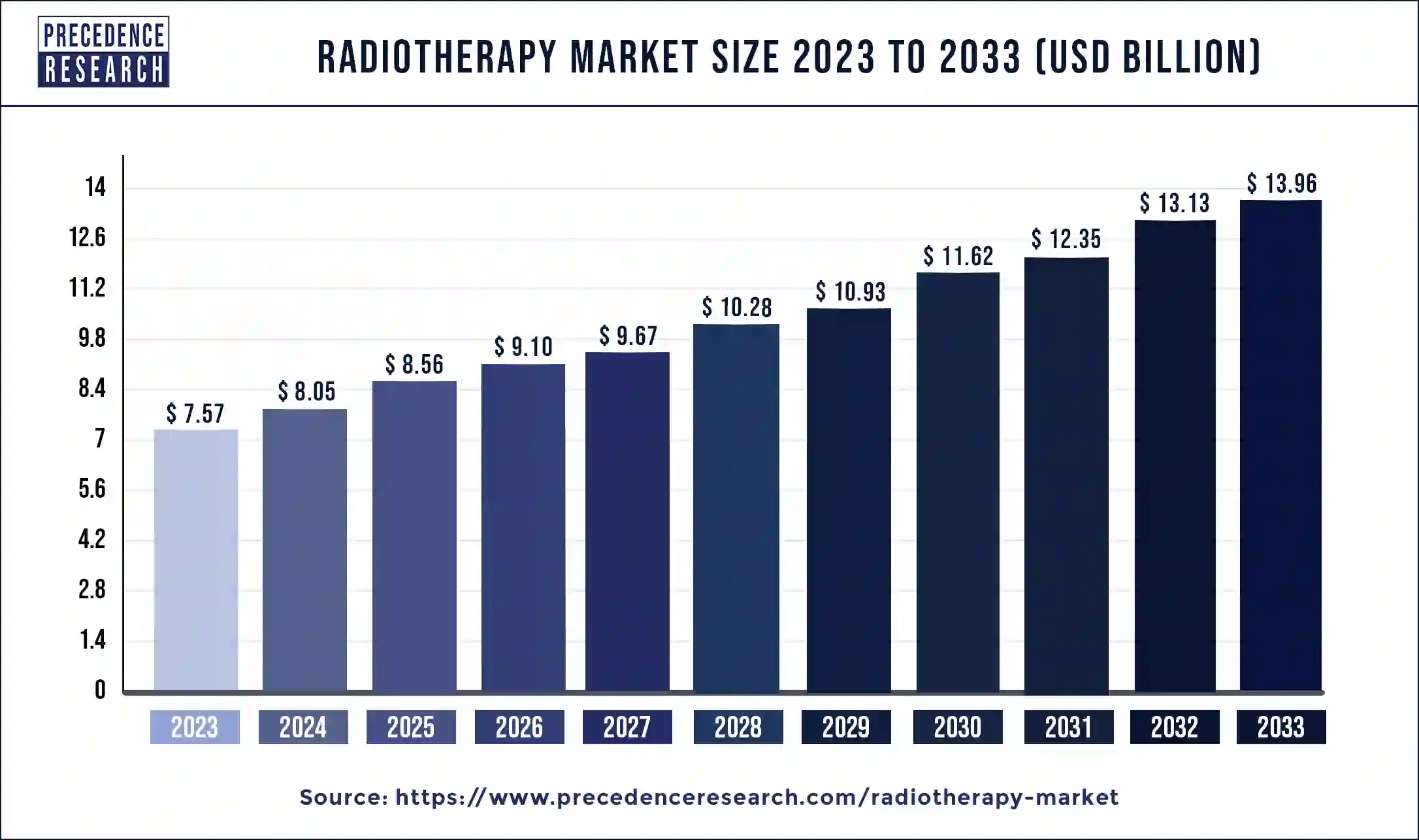
The U.S. radiotherapy market was estimated at USD 2.10 billion in 2023 and is predicted to be worth around USD 3.95 billion by 2033, at a CAGR of 6.52% from 2024 to 2033.
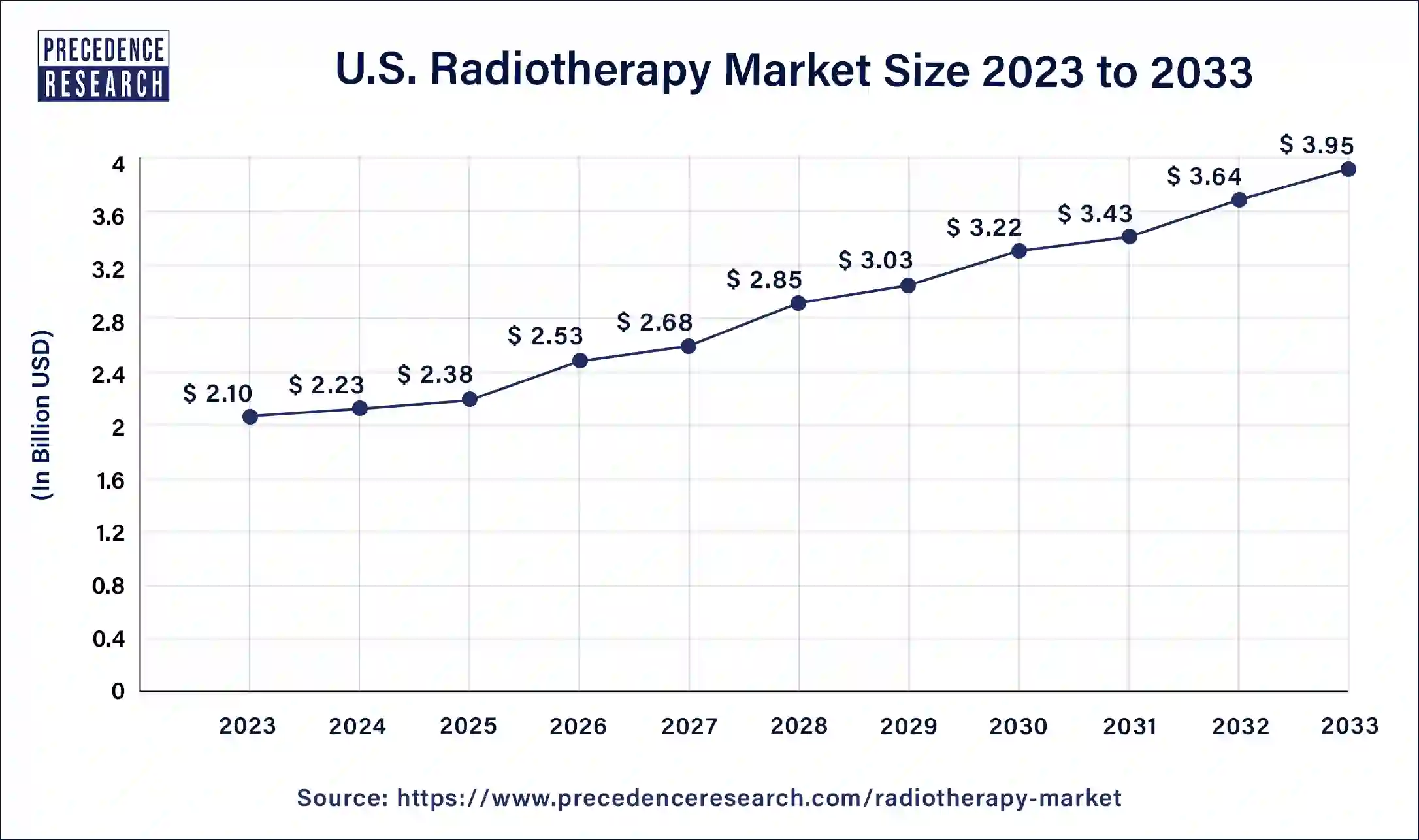
North America dominated the radiotherapy market in 2023. The healthcare infrastructure in North America, especially in the U.S. and Canada, is highly developed and facilitates the use of advanced medical treatments like radiotherapy. Due to the high level of healthcare spending in the area, large investments in advanced radiotherapy facilities and equipment are possible. The innovation and research in medicine are centered in North America. North America is home to several important research institutes and producers of radiotherapy treatment equipment, which propels innovation and the early uptake of new technology.
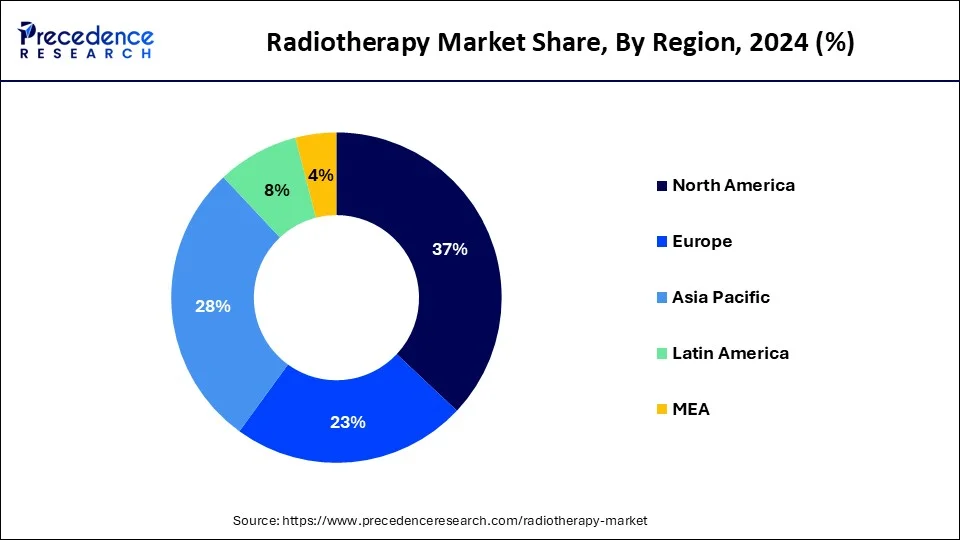
Asia Pacific is expected to grow at the highest CAGR in the radiotherapy market during the forecast period. One of the main factors driving the need for radiotherapy in the region is the rising incidence of cancer. Due to aging populations, changing lifestyles, and other risk factors, countries like China and India have noticed an increase in cancer cases, leading to the need for more advanced treatment options like radiotherapy. Proton therapy, intensity-modulated radiation therapy (IMRT), and image-guided radiotherapy (IGRT) are among the advanced radiotherapy technologies being adopted in Asia Pacific. By providing more individualized care, these technologies improve patient outcomes and spur the radiotherapy market expansion.
Radiotherapy Market Overview
The radiotherapy market refers to the industry that deals with the use of high radiation doses in radiotherapy as a medical procedure to destroy cancer cells and reduce tumor size. The radiation causes damage to DNA cells, which stops the cells from proliferating and reproducing. There are different types of radiotherapy, including external beam radiation therapy, internal radiation therapy, and systemic radiation therapy. The radiotherapy market is driven by the growing adoption of radiotherapy devices and procedures and the rising incidence of cancers.
Radiation therapy contributes to 40% of all cancer cures world-wide as well as improving the quality of life for many others. Despite this great benefit, the total cost of radiation therapy to the Commonwealth government is less than 9 cents in every dollar spent on all cancer diagnosis and treatment. Each year of life saved in Australia by radiation therapy costs us less than one saved using other cancer treatments.
The radiotherapy market is fragmented with multiple small-scale and large-scale players, such as Eckert & Ziegler Group, Elekta AB, Ion Beam Applications SA, Becton, Dickinson and Company, MEVION MEDICAL SYSTEMS, INC., Isoray, Inc., Siemens Healthineers AG, ICAD INC., Accuray Incorporated, Nordion Inc.
| Report Coverage | Details |
| Radiotherapy Market Size in 2023 | USD 7.57 Billion |
| Radiotherapy Market Size in 2024 | USD 8.05 Billion |
| Radiotherapy Market Size by 2033 | USD 13.96 Billion |
| Radiotherapy Market Growth Rate | CAGR of 6.31% from 2024 to 2033 |
| Largest Market | North America |
| Base Year | 2023 |
| Forecast Period | 2024 to 2033 |
| Segments Covered | Type, End-user, and Regions |
| Regions Covered | North America, Europe, Asia-Pacific, Latin America, and Middle East & Africa |
Drivers
Rising incidence of cancers
The rising incidence of cancers can boost the radiotherapy market. The need for efficient treatment alternatives rises in tandem with the number of cancer patients. One of the mainstays of cancer treatment is radiotherapy, which can be administered either on its own or in conjunction with other therapies like chemotherapy and surgery. The need for radiation services increases as the number of cancer patients receiving a diagnosis rises.
Growing the adoption of radiotherapy devices and procedures
The growing adoption of radiotherapy devices and procedures can grow the radiotherapy market. The effectiveness and safety of treatment are improved by the ongoing development and use of cutting-edge radiation equipment and methods. Enhancing patient outcomes and reducing harm to surrounding healthy tissues, innovations like intensity-modulated radiation treatment (IMRT), stereotactic radiosurgery (SRS), and image-guided radiation therapy (IGRT) allow for more accurate targeting of malignancies. This promotes the use of these technologies by more healthcare professionals, hence growing the market.
Restraint
Lack of skilled professionals
The lack of skilled professionals to operate the radiotherapy may slow down the radiotherapy market. Medical physicists, radiologic technologists, and radiation oncologists are among the highly skilled individuals needed for radiotherapy in order to handle complicated equipment and guarantee precise treatment delivery. The number of patients that can be treated is limited by a lack of these specialists, which lowers the total capacity of radiation treatments.
Opportunity
Production of advanced technology
The advancement of technology in radiotherapy presents an opportunity to enhance the radiotherapy market. This includes the use of multileaf collimators, integrating imaging techniques such as positron emission tomography (PET) and computed tomography (CT), employing advanced dose calculation algorithms, and implementing delivery techniques that improve tumor dose distribution and reduce normal tissue toxicity. These advancements have the potential to boost the market.
The external beam radiation therapy segment dominated the radiotherapy market by type in 2023. Technological advancements in EBRT include image-guided radiation treatment (IGRT), volumetric modulated arc therapy (VMAT), intensity-modulated radiation therapy (IMRT), and stereotactic body radiation therapy (SBRT). Because of these developments, external beam radiation therapy is now the recommended option for many cancer therapies because of its increased safety, efficacy, and accuracy. Because of its adaptability, external beam radiation therapy may be used to treat a variety of malignancies, such as those of the head and neck, breast, lung, and prostate. Its versatility to different tumor sizes and locations makes it a therapeutic option that is extensively used, which contributes to its supremacy. Due to its shown efficacy and comparatively reduced setup costs when compared to other cutting-edge therapies like proton therapy, EBRT has been implemented in many healthcare institutions, particularly in developed nations. This extensive accessibility has increased its broad availability.
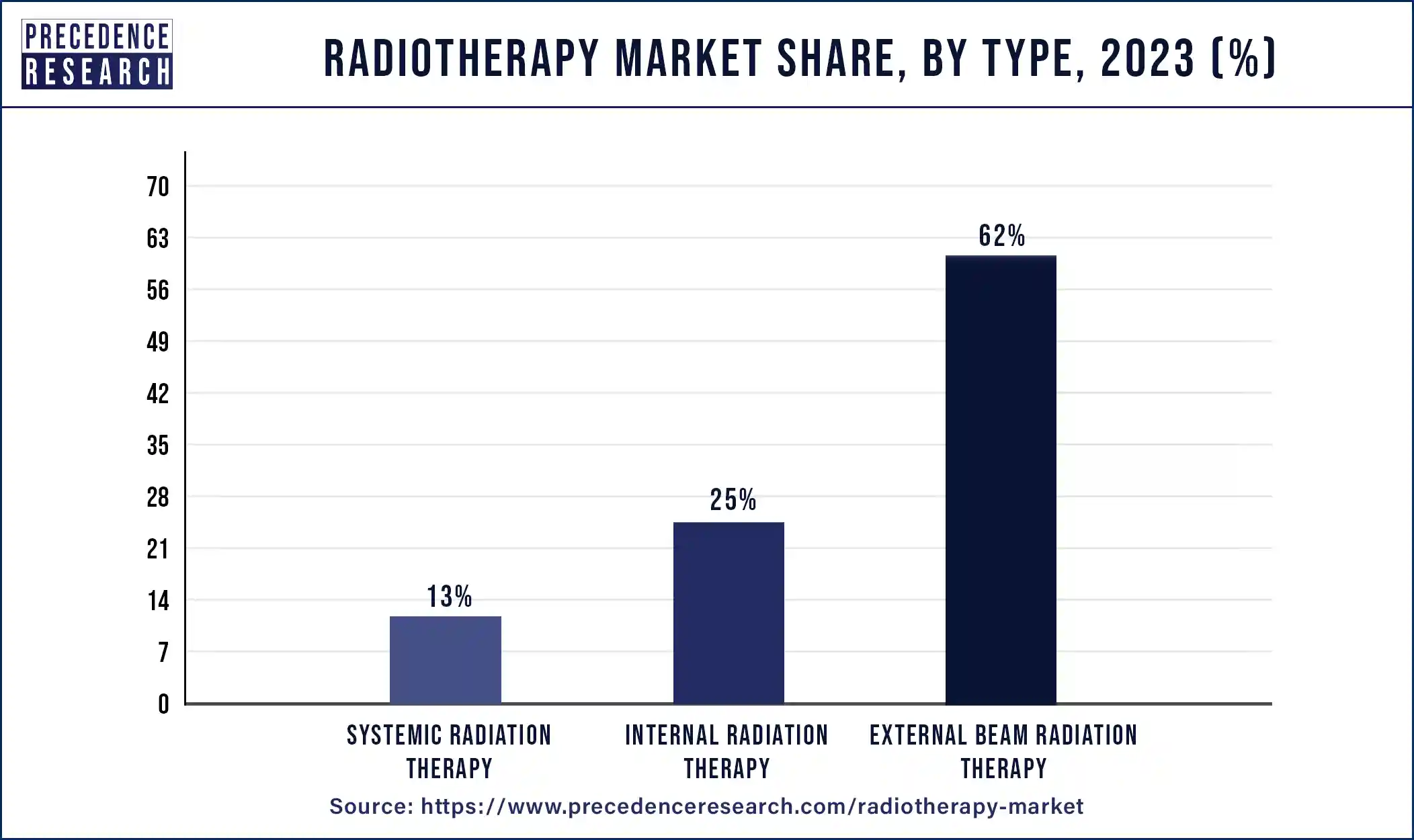
The internal radiation therapy segment is expected to show notable growth in the radiotherapy market during the forecast period. The portion of internal radiation therapy is sometimes referred to as internal radiation therapy. By positioning radioactive sources inside or close to the tumor, internal radiation therapy enables very precise delivery of radiation doses. This improves therapeutic efficacy and reduces harm to nearby healthy tissues, improving patient outcomes. Internal radiation therapy is now being used to treat malignancies other than those that are typically treated with it, such as skin, rectal, and prostate cancer. Its acceptance and market expansion is accelerated by this wider range of applications. The safety and effectiveness of internal radiation therapy have been greatly increased by developments in imaging and delivery methods. Internal radiation therapy is becoming more and more popular among patients and physicians thanks to innovations like high-dose-rate (HDR) internal radiation therapy and the incorporation of imaging technology like MRI and CT for treatment planning.
The hospitals & clinics segment dominated the radiotherapy market in 2023. Comprehensive cancer care, including diagnosis, treatment, and follow-up, is frequently offered by hospitals and clinics. They are the main locations for cancer treatment because they have the facilities and tools needed to provide a variety of radiation services. Modern radiation technology, including linear accelerators, CT simulators, and MRI equipment, is usually found in hospitals and clinics. The patients looking for the newest and most efficient treatments are drawn to them because of their capacity to purchase and maintain cutting-edge technology.
The other segment is expected to grow rapidly in the radiotherapy market during the forecast period. The other category includes outpatient radiation centers, research institutes, and specialty cancer centers. Modern radiation therapies and technologies are frequently provided by specialized cancer clinics and outpatient radiotherapy facilities, which concentrate solely on the treatment of cancer. The patients seeking specialized cancer care are drawn to them because of their specialty, which enables them to perform radiation therapy with a high degree of knowledge and efficiency. The specialized facilities and research institutes are frequently at the forefront of innovative radiation practices. They take part in research investigations and clinical trials that result in the implementation of state-of-the-art procedures and technology. Their capabilities and attractiveness are improved by their ongoing innovation. The patients can receive treatment at outpatient radiation clinics without having to be admitted to the hospital, which is convenient for them. This type is especially attractive to patients who need frequent radiation treatments, which is helping to propel this market forward.
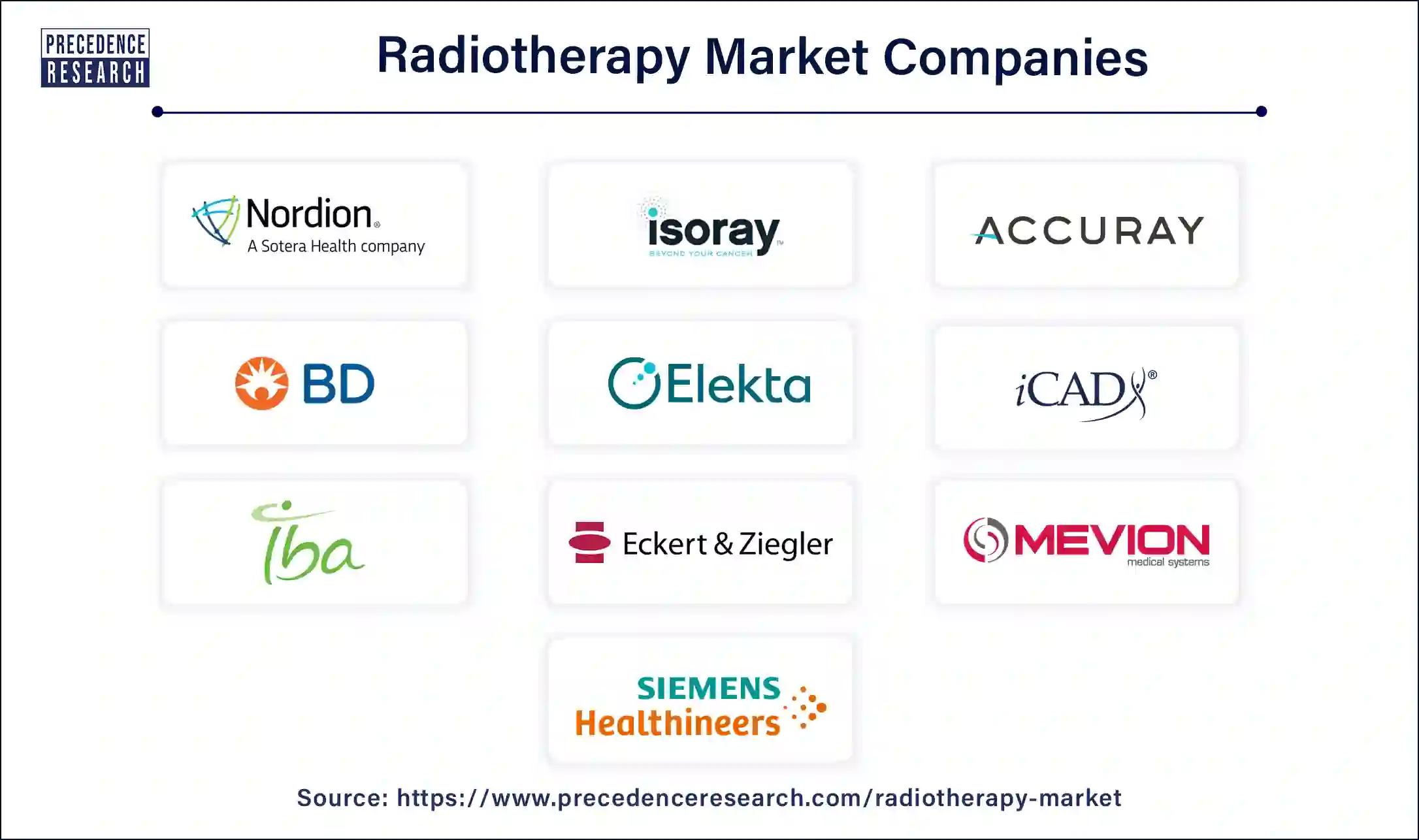
Segment Covered in the Report
By Type
By End-user
By Geography
For inquiries regarding discounts, bulk purchases, or customization requests, please contact us at sales@precedenceresearch.com
No cookie-cutter, only authentic analysis – take the 1st step to become a Precedence Research client